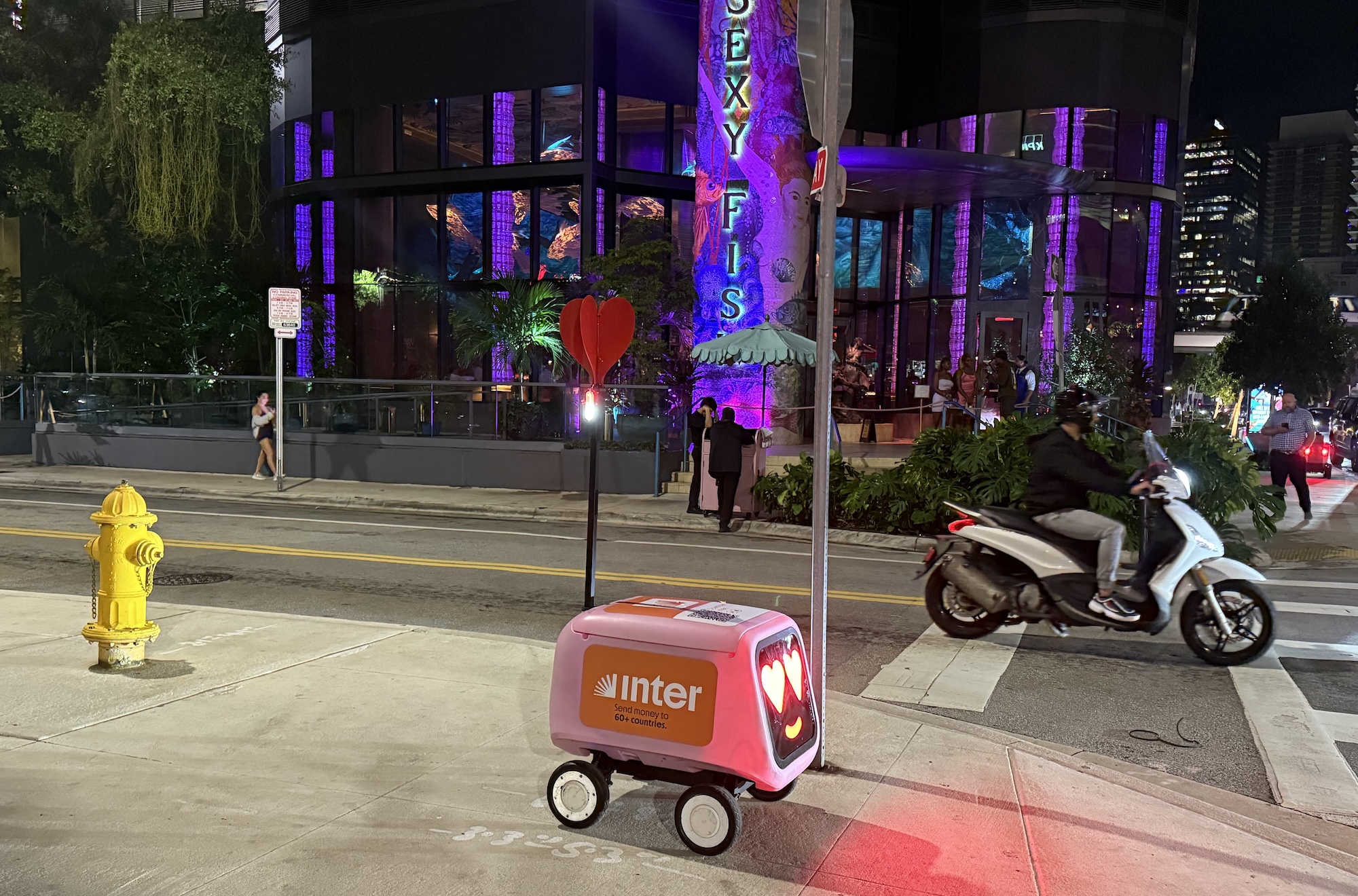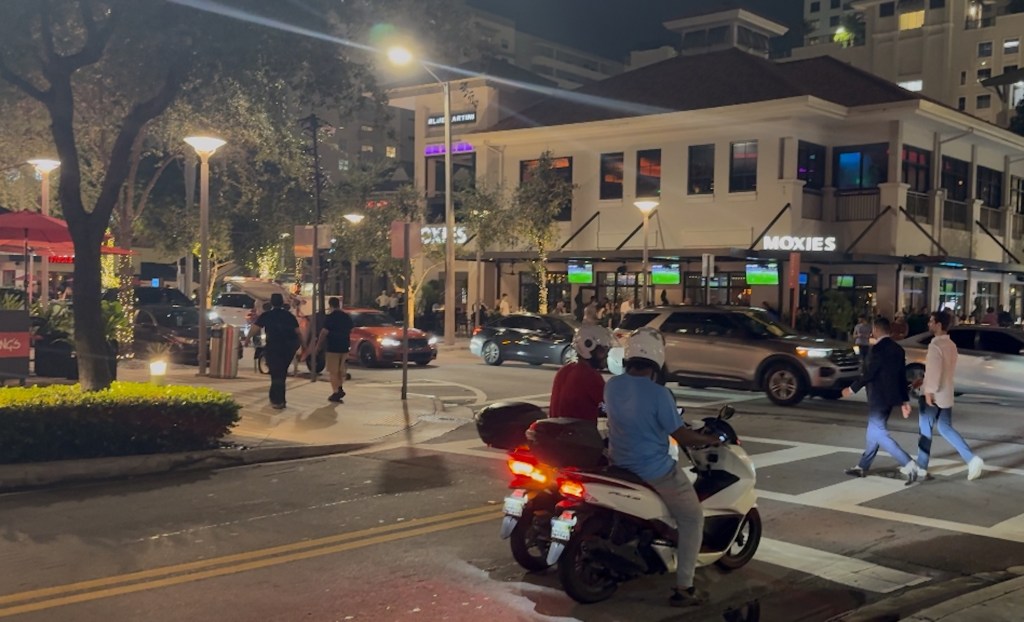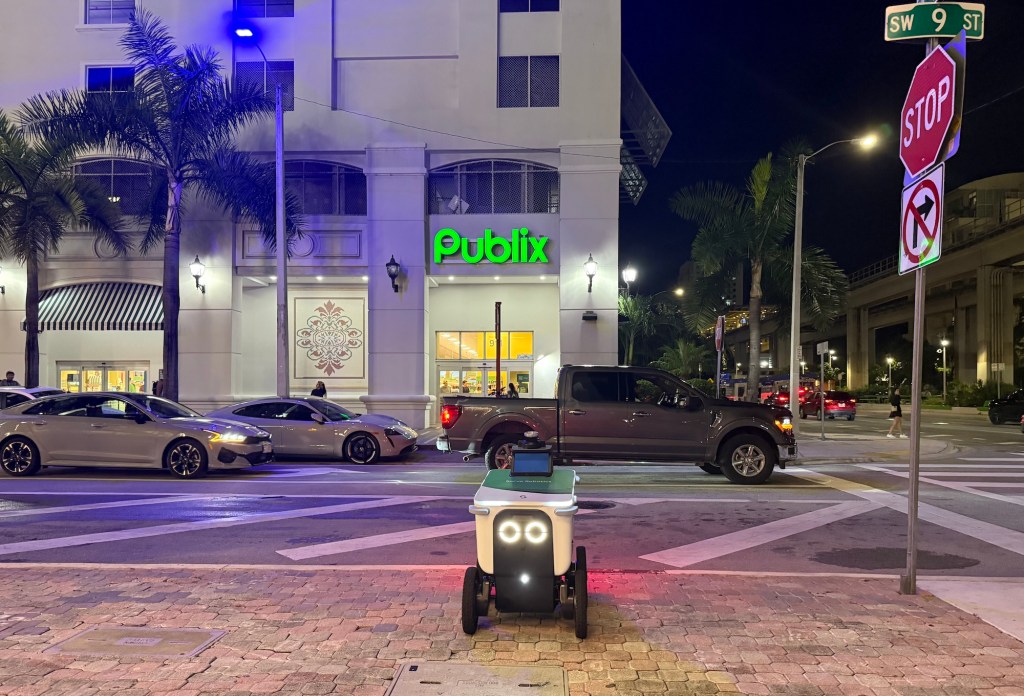
Photo by Luis Pascal/Caplin News

Audio By Carbonatix
On a cloudy recent evening in Brickell, traffic clogs the streets as commuters hurry home. At 6 p.m., 39-year-old José Torres sits on his scooter, helmet half open, scrolling through his phone while waiting for his next order. For Torres, a Cuban immigrant, delivery driving is his only source of income.
Lately, he has noticed something troubling.
Many restaurants on routes where he frequently drove in Coconut Grove and Miami Beach were closing. Some shut their doors permanently, others for a break over the summer, but the result is the same — fewer orders for drivers like him. And now, delivery robots are taking a portion of the drivers’ business, too.
Some drivers’ incomes have been cut in half.
This year, make your gift count –
Invest in local news that matters.
Our work is funded by readers like you who make voluntary gifts because they value our work and want to see it continue. Make a contribution today to help us reach our $30,000 goal!
“Look, my [main] route used to be Miami Beach, I’d see the ocean and do my deliveries,” Torres says. “But I had to change the routes; now it costs me more, and I make less money.”
With only his scooter and phone, Torres has had to leave his usual area, risking hours with no orders, hoping to make more money in other neighborhoods. He takes pride in helping people. Each order feels like an accomplishment, ensuring customers are fed, keeping the city moving, and supporting his family back in Cuba.
“My goal is to make enough [money] to send it back home to help my family,” Torres says.
Miami is a great city for foodies, but this summer has seen an unusually high number of permanent and temporary restaurant closures, according to observers, including some well-established eateries helmed by prominent restaurateurs and chefs. The reasons for the falloff are unclear, but may include a dip in tourism, rising operational costs, an oversaturation of dining options, and changing customer habits.

Photo by Luis Pascal/Caplin News
After a decade on Miami’s streets, delivery driver Modesto Espinal has learned that the job offers no guarantees. Drivers are always in survival mode. With so much competition, the business feels like a race where only the fastest drivers win the best rewards.
Espinal says that last summer he averaged about $650 a week, excluding tips, but now, with more restaurants closing, he makes closer to $240 and is forced to move constantly from area to area to pick up business.
“The change of routes is constant,” the 59-year-old says. “It’s not like working in a regular job where you just do your shift. Here, you’ve got to hustle every day because the work itself is unstable.”
Espinal quickly ends the conversation, adjusts his helmet, and speeds away to chase his next order.
Another driver, who asked to be identified only by his nickname, Sosa, says he never expected to see so many restaurants shut down. To stay afloat, Sosa now works for three different apps, although maintenance costs and taxes eat away at his earnings.
“It’s not normal for a lot of people,” says the 54-year-old, who is based in Hialeah. “But for us, it’s the only way to make up for the losses.”
Where the High-Rises and High Incomes Are
In Brickell, the upscale neighborhood is filled with skyscrapers and restaurants where delivery drivers gather after sunset. They know the best money comes at night.
The dinner rush often determines whether the day was worth it, with tips making the difference between just breaking even or bringing home decent money.
On average, for an order totaling about $25, the driver can expect to make around $6, which includes a base pay of roughly $3 and an additional $3 from the tip.
“I live off tips, man,” says 46-year-old Arnold Falcón, who has been delivering food in Miami for five years. “Without tips, this business doesn’t work.”
According to a report by FinanceBuzz, delivery apps like Postmates can charge customers up to 92% more than the menu price, with some Chick-fil-A orders more than doubling in cost before tips. The report notes that pickup orders can save customers a significant amount of money compared to delivery.
“I used to make more money with just two orders from a nice restaurant than with five fast-food runs,” says 39-year-old longtime delivery driver Jason Dominguez. “They paid better, tipped better. Now I have to chase whatever pops up, even if it pays less.”
However, not all drivers reported facing a downturn this summer. Carla Diaz, 35, says she hadn’t heard about restaurants closing and has not been affected by it. Diaz works near malls and busy shopping areas, where fast-food chains keep her busy.
“As long as people want food, I’m not really feeling the difference,” she adds.

Photo by Luis Pascal/Caplin News
Enter the Robots
As if restaurant closures weren’t enough, delivery drivers are facing another challenge: delivery robots.
Earlier this year, small delivery robots called “Saymo,” made by Serve Robotics, a company that develops and operates autonomous robots for food delivery, started rolling through sidewalks in Brickell, Miami Beach, and elsewhere.
They pick up food from restaurants and bring it straight to customers’ door,s and have become a regular part of food delivery as Uber Eats and DoorDash add them in major cities like Los Angeles, Dallas, and Miami.
In early 2025, Serve Robotics partnered with Uber Eats to deploy up to 2,000 robots. Since its launch in 2020, the company has completed more than 500,000 deliveries.
“For the first time in my life, I saw this little car bringing me food,” says Joel Miranda, a tourist from Spain. “It was surprising.”
However, human drivers remain essential to the gig economy, and that’s unlikely to change, according to one expert.
“Drivers won’t be replaced wholesale any time soon,” predicts Kevin Greiner, an urban planner and economist in Miami who focuses on issues causing regional economic change and the future of cities. “Fully robotic delivery only works in dense, highly urbanized neighborhoods.”
One of the issues that has affected delivery drivers, Greiner says, is that companies like Uber Eats and DoorDash classify them as independent contractors —a move aimed at saving money and limiting legal responsibility. Uber Eats and DoorDash did not respond to requests for comment.
“The shift from employees to independent contractors has resulted in a negative impact on (driver) wages and benefits, despite growth of the industry,” Greiner says.
Despite the challenges, Miami’s delivery drivers continue to persevere.
For Torres, every day tests his patience, but he remains hopeful that closures won’t last forever. Quitting isn’t an option; his family in Cuba depends on him.
“This is like any business,” he says. “Even if robots take our jobs in the future, we’ll adapt to the changes and keep doing what we do best — working.”
Editor’s note: This story is the result of a partnership with Florida International University’s Lee Caplin School of Journalism & Media.
Correction published 10/11/25: This story has been edited to correctly identify Serve Robotics’ delivery robot. The robot is called “Saymo,” not “Coco.”